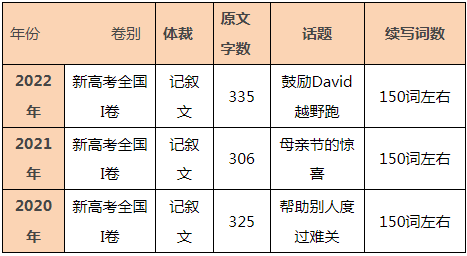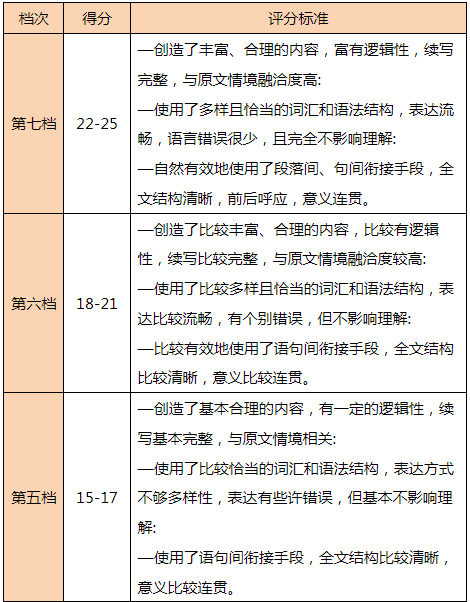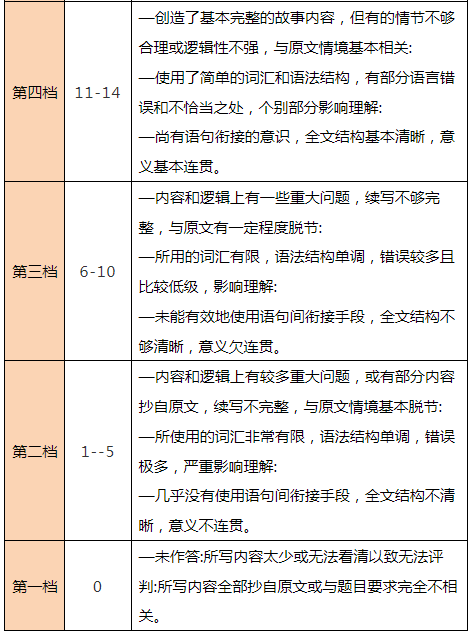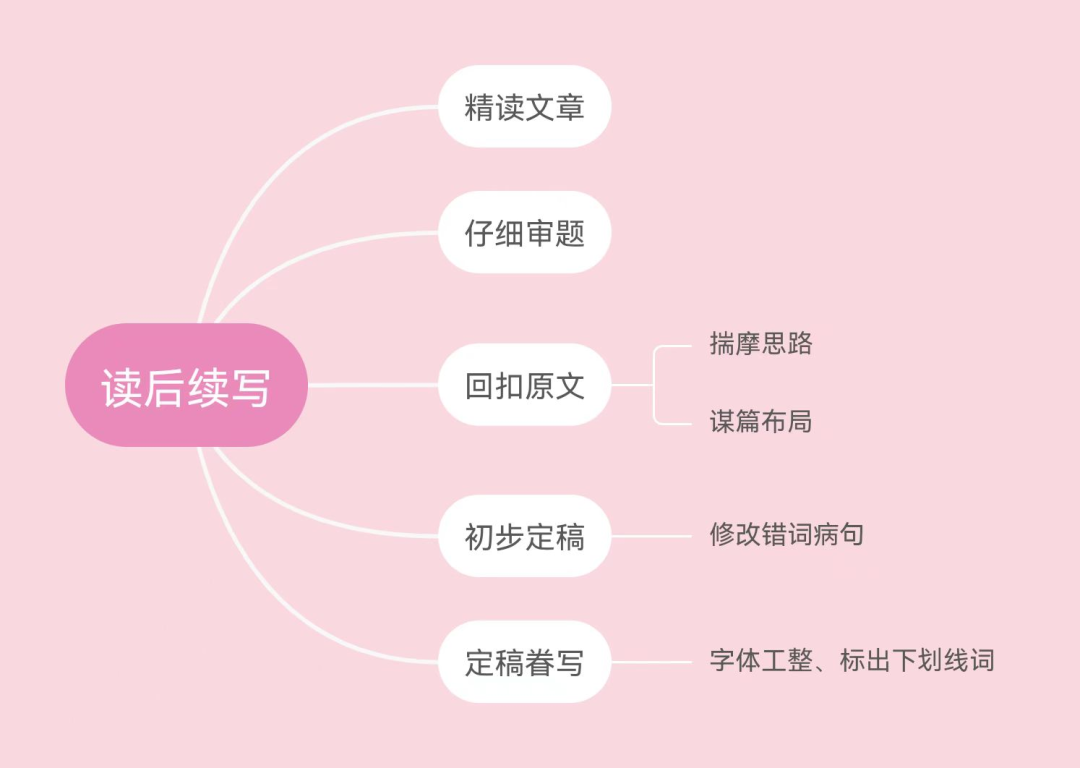日期:2023-04-06 09:42 點擊:
近三年讀后續寫考情分析+評分標準 +寫作指導
目錄
1. 讀后續寫考情分析
2. 讀后續寫評分標準
3. 讀后續寫評分標準解讀
4. 寫作指導思維導圖
5. 易錯點
6. 真題解讀
【考情分析】
讀后續寫"是高考英語中新增加的一種寫作題型,從2016年開始應用于高考綜合改革試點省份的高考中、并且將隨著高考綜合改革試點的推廣在全國范圍內使用。所提供短文詞數在350左右,劃線詞語涉及到名詞(詞組)、動詞(詞組)、介詞(詞組)和形容詞等,其中,以名詞(詞組)為主,在續寫中至少要使用5個關鍵詞語。讀后續寫多以記敘文故事類文章或者夾敘夾議類文章為主,所考察的主題為人與自然,人與動物或者人與自我。
要求考生在理解一篇不完整文章的基礎上,充分調動想象創新思維,大膽預測文章缺失部分的內容走勢,進行充滿個性色彩的設計,故事情節有曲折、有起伏,邏輯性比較強。在使用關鍵詞語時根據時態和語態的需要,可以改變動詞的形式,可以改變名詞的單復數,但不要改變關鍵詞語在原文中的含義和詞性。
讀后續寫的文章特色:
1.創造性:即發揮想象力,該題型具有一定的開放性,考生需用自己的語言對故事情節進行內容創造;
2.邏輯性:即根據已提供的關鍵信息,按照可能的合理的方向續寫,使文章邏輯結構完整;
3.豐富性:即語言能力的充分體現,詞匯句法的準確與復雜程度,細節描寫的生動性等都將讓故事更加立體飽滿。

【評分標準】
1. 本題總分為25分,按七個檔次進行評分。
2. 評分時,主要從內容、語言表達和篇章結構三個方面考查,具體為:
(1)續寫內容的質量、續寫的完整性以及與原文情境的融洽度。
(2)所使用詞匯和語法結構的準確性、恰當性和多樣性。
(3)上下文的銜接和全文的連貫性。
3. 評分時,應先根據作答的整體情況確定其所屬的檔次,然后以該檔次的要求來綜合衡量,確定或調整檔次,最后給分。
4. 評分時還應注意:
(1)詞數少于120的,酌情扣分;
(2)單詞拼寫和標點符號是寫作規范的重要方面,評分時應視其對交際的影響程度予以考慮,英、美拼寫及詞匯用法均可接受;
(3)書寫較差以致影響交際的,酌情扣分。


【評分標準解讀】
總體來看,讀后續寫以讀為輔,以寫為主,其目標是考查學生的綜合語言運用能力。評分標準是評分的依據和絕對標準。
依據評分標準,讀后續寫主要考查閱讀理解能力,由讀到寫的思維能力和語言表達運用能力三個方面。評卷時,評卷老師先根據考生所續寫短文的內容和語言初步確定其所屬檔次,然后以該檔次的要求來衡量,確定或調整檔次,最后給分。
閱卷老師在閱卷時,主要考慮以下內容:
1.與所給短文及段落開頭語的銜接程度;
2.內容的豐富性;
3.應用語法結構和詞匯的豐富性和準確性;
4.上下文的連貫性。
【寫作指導】

1. 瀏覽信息, 確定文章線索。 每篇文章都有各自獨特的寫作思路,通過精讀文章,找到該篇文章的寫作線索,如是以時間為線索還是以空間為線索等,這樣有利于考生“順藤摸瓜(結尾)”。
2.仔細審題, 確定主要情節。一般短文后面的“注意”都有對此次短文續寫的具體要求,如詞數限制、使用幾處下劃線關鍵詞語、續寫段落的首句提示,這樣有利于考生做到“心中有數”。
3.回扣原文, 確定續寫段落內容。根據文章后面的要求,再次快速回讀短文,抓住文章的思路,結合段首的提示語,最終確定續寫段落的思路,同時結合文章畫線詞語提示,確定續寫段落的內容。
4.擬寫草稿,修改錯詞病句。在確定了思路和內容之后,最關鍵的就是結合提示語或者文中畫線的關鍵詞擬寫草稿。擬寫時,注意句子結構的多樣性,語言的豐富性,并通過句與句之間連接詞的正確使用,使上下文連貫。
5. 標出續寫部分原材料中標有下劃線的關鍵詞。這一點可以幫助考生自己檢查關鍵詞的使用情況并根據情況做出修改。最后在謄寫文字時,務必做到“字跡工整”。
【易錯點】
1. 忽視文體的一致性。
如果文章是對話性較強的,我們在續寫時要注意對話的使用,反之,如果文章以講述為主,我們就要進行講述,切忌前后文體不一。
2. 忽視每段首句的導向性。
有的文章是夾敘夾議類的,作者會在最后一段對事情進行評論。如果第二段的首句是評論性語言,我們要順著這個方向寫下去。
3. 忽視與所給短文及段落開頭語的銜接。
這是續寫最常犯的錯誤。我們有時只考慮故事情節的延續,忽視了與段落開頭的銜接,這樣很容易偏離主題。
4. 忽視第一段結尾部分與第二段開頭的銜接。
第二段的開頭起到承上啟下的作用,因此第一段的結尾部分一定要與第二段的開頭有所銜接。
5. 忽視應用語法結構和詞匯的豐富性和準確性。
切忌時態、人稱等的混亂使用,這將會影響得分,同時豐富的詞匯以及詞匯使用的準確性也能彰顯我們的英語水平,給我們的續寫添彩。
7. 忽視內容的豐富性和對所給關鍵詞語的覆蓋情況。
將故事情節寫得富有變化,同時不忘畫線詞語的覆蓋率。
【真題解讀】
【2022年高考英語浙江卷1月】
閱讀下面短文,根據所給情節進行續寫,使之構成一個完整的故事。
When Dr. Henderson was assigning (指定)project mates for his psychology class, I secretly hoped he would pair me with my best friend or at least a classmate I could have some fun with. Above all, I hoped he wouldn't assign me to work with the fiercely competitive, extremely serious fellow who always wore dark clothes and apparently had a personality to match. As fate (命運)would have it, Dr. Henderson very deliberately matched everyone in class and announced that I would be working with the one person in class I wanted to avoid.
I went up to my new teammate and introduced myself. He looked at me as though I weren't there. I felt he treated me as though I would hold him back and probably make him fail to get an A in the course. He wasn't mean or abusive; he just gave me the impression he could do whatever project we dreamed up better if he did it alone.
Needless to say, I didn't look forward to an entire term of being brushed off, but I tried to make the best of it and didn't say anything for fear that I would make things worse.
The project required each team to develop a hypothesis ({段說),set up an experiment to test the hypothesis, do the statistical analysis and present the findings. Whatever grade the team received would be shared by both students.
When my teammate and I met to discuss our project, I was uneasy. Here was this challenging student who had a reputation for single-mindedness and good grades—the exact opposite of me. I was outmatched. I actually wanted to drop the class at one point, but stopped short because I didn't want to give him the satisfaction of my chickening out. I decided to stick to it no matter what.
After long discussions we somehow agreed to do a study on the psychological well-being of teenagers. I wasn't sure what it meant exactly, but at least we had a topic.
注意:
1. 所續寫短文的詞數應為150左右;
2. 至少使用5個短文中標有下劃線的關鍵詞語;
3. 結部分分為兩段,每段的開頭語己為你寫好;
4. 續寫完成后,請用下劃線標出你所使用的關鍵詞語。
Para 1.
We started to meet regularly to draw up our plans.
Para 2.
One day I got word that he was admitted to hospital for a serious disease.
【參考范文 】
We started to meet regularly to draw up our plans. Though I wanted to share my ideas with him fully, I failed to do so for fear that I would hold him back. I just kept nodding when he asked me whether it is ok to do this way or that way. I thought it was impossible to persuade him into accepting my views, so I didn’t want to waste our time to discuss. I started to wait to leave immediately we arrived at the place, and so did he. I just hoped that the presentation day could come earlier.
One day I got word that he was admitted to hospital for a serious disease. I felt so sorry to hear that and I thought I should visit him in any case. He was a little surprised to see me when I stepped into his ward with some flowers and fruits. I offered to do the rest work of our project and he invited me to share my ideas to perfect it. We began to work as a fine team and finally finished our project on time. Our hard work paid off and Dr. Henderson’s was very satisfied with our wonderful findings. From this project, we also learned the significance of teammates. Just as the saying goes, one person can go far, but a group of persons can travel farther.
語篇大意:本文講述了作者在一次課上被分配了一個不想要的隊友并共同完成作業,他們從最初的無法配合到最后圓滿完成任務的溫暖故事。
續寫與段落的銜接:第一段首句中meet regularly可知,作者最初的“不太合作”的心態在慢慢改變。
第二段首句to hospital for a serious disease可以推測出,作者會因為同伴的住院而感到心情低落,并繼續努力完成項目。此時,作者的心態已經由最初的不合作、觀望等最終轉變成立全力以赴地去拼搏。
高分詞匯:
動作類:
①與...分享:share sth with sb / exchange sth with sb
②沒能做:fail to do/be unable to do /not make it
③到達 : arrived at /get to /reach/
④走進:step into/enter/come into
情緒類
①驚訝的:surprised/amazed/shocked
②滿意的:satisfied/content/pleased
[高分句型1].(使用了“so+(助)動詞+主語”表示“….…也一樣”的倒裝句型)
I started to wait to leave immediately we arrived at the place, and so did he.
[高分句型2].(使用了though 引導的讓步狀語從句) Though I wanted to share my ideas with him fully, l failed to do so for fear that I would hold him back.